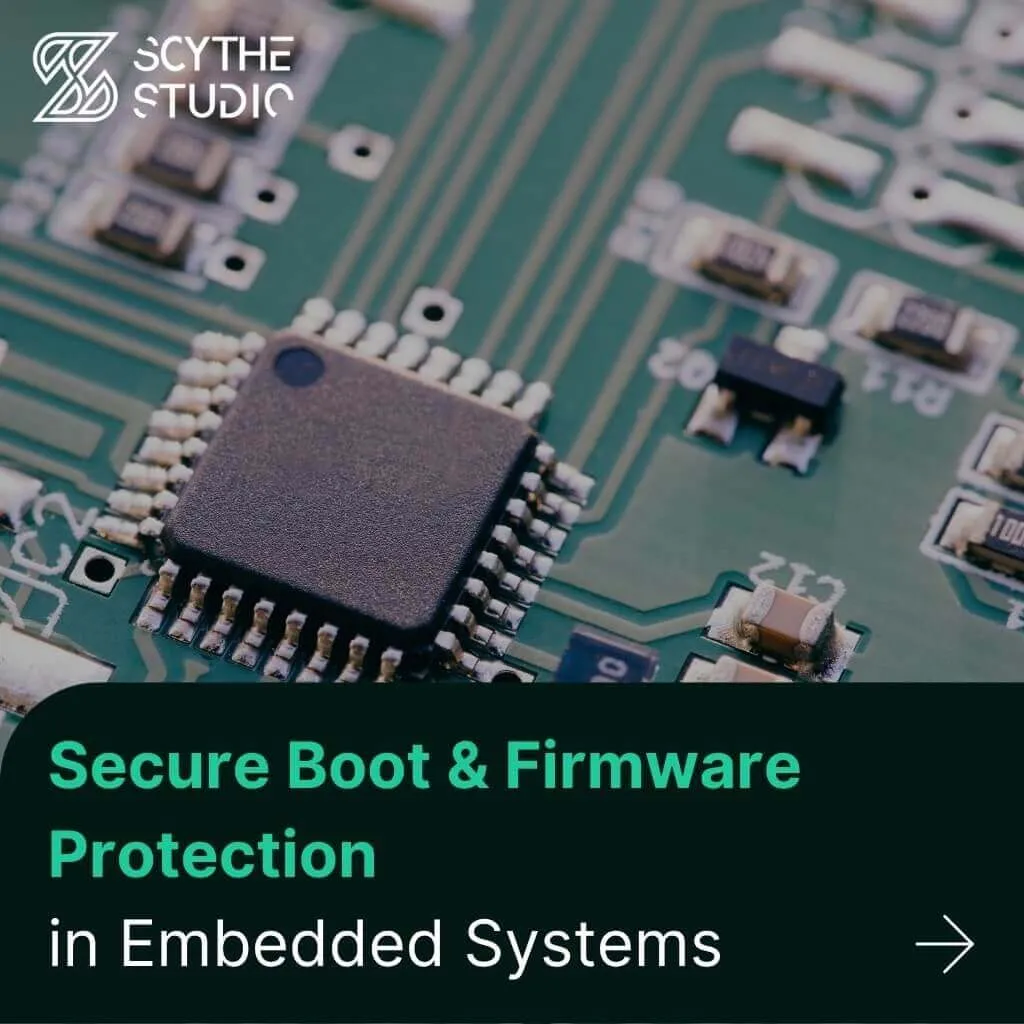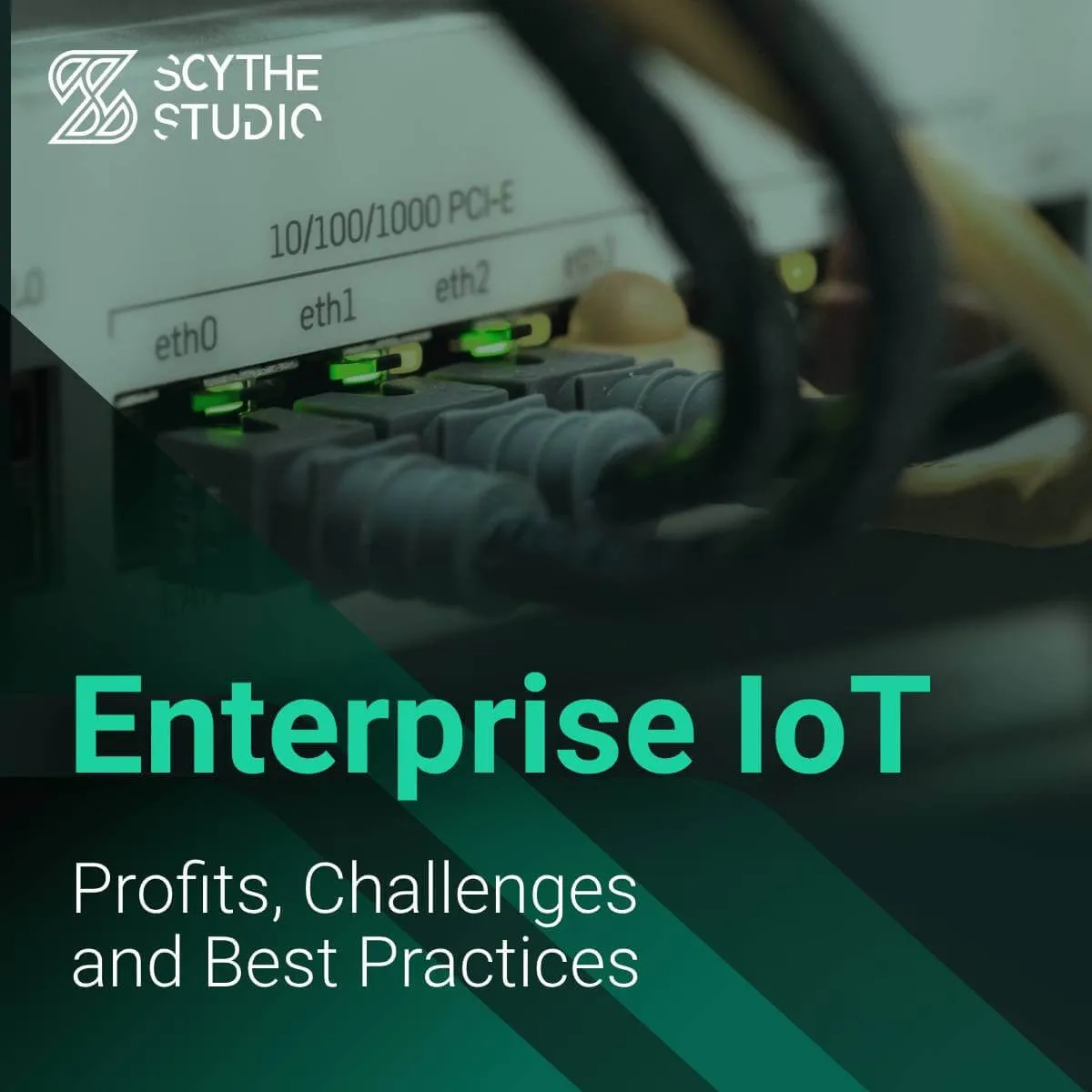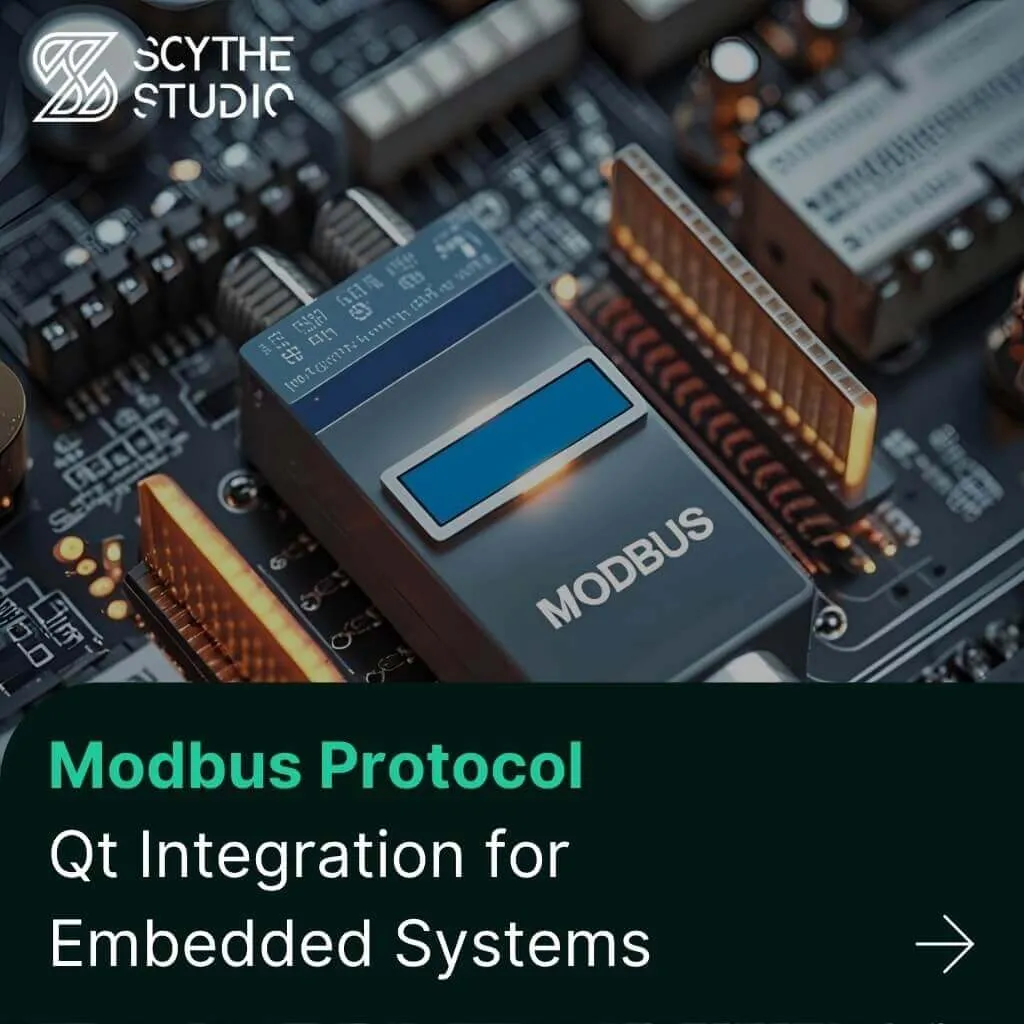
Secure Boot and Firmware Protection in Embedded Systems
Users of embedded devices – from industrial controllers to consumer electronics – are often unaware of hidden vulnerabilities that threaten […]

For me, the most interesting and funniest thing about introducing Enterprise IoT solutions in companies is that engineers are well aware of the need for such a system. Engineers or leaders who are close to the production are well aware of the shortcomings and dangers of, for example, not being able to remotely monitor devices or do backward analysis when something has gone wrong.
So the idea of this article is to share with you our main observations from providing Electronics and IoT Development services. You will learn why to implement Enterprise IoT solutions and we will give some examples of such systems.
Enterprise IoT is IoT (Internet of Things) technology in big organizations to connect devices, systems, and IoT sensors, to collect real-time data, automate and make intelligent decisions. It’s about integrating many devices, including embedded computing devices across an IoT ecosystem into one network.
The idea is to let businesses monitor, manage, and optimize their processes better. Companies can automate workflows, reduce manual intervention, and improve operational efficiency by using connected technologies. Enterprise IoT is a key part of digital transformation and staying competitive by enabling smarter business decisions through advanced analytics.
Enterprise IoT is becoming more and more important for big companies as the need for adaptability, resilience and digital integration in a competitive world grows. As businesses are under pressure to improve customer experiences, simplify operations, and automate workflows, enterprise IoT solutions become the foundation for achieving that.
The move to real-time data, predictive analytics, and connected systems is driven by the need to be agile and proactive in a changing world. With supply chains getting more complex and customer expectations higher, IoT is key to visibility, responsiveness, and staying ahead of the curve while ensuring efficient IoT device management. Not to mention that in the long term, businesses operate more efficiently and therefore save money.
 Robot Device Communication
Robot Device Communication
One of the biggest benefits of IoT devices is to improve operational efficiency and reduce operating costs. By using smart sensors and real-time data analytics and machine learning, businesses can automate routine tasks, optimize energy usage, reduce equipment failures, and streamline logistics. The result is not only cost savings but better inventory management and less downtime. This operational efficiency optimizes every part of a business, from supply chains to internal workflows, delivering significant investments in long-term productivity gains.
IoT systems allow real-time monitoring of working conditions so you can spot and mitigate potential risks. For example in industrial environments, industrial IoT applications can detect equipment failures, and changes in environmental conditions and ensure health and safety regulations are met. However, integrating these systems also introduces a new security risk requiring robust enterprise IoT security measures. A proactive approach with IoT means fewer accidents, safer employees, better working conditions, and reduced liability and costs.
I know the cases of production companies having a failure rate is often higher than 40%. This is most often a cumulative problem of human error, but the problem is that without the right Enterprise IoT systems, there is no way to really check what went wrong and at what stage in order to make beneficial changes in the future.
With IoT you can collect and analyze vast amounts of sensitive data from multiple sources, to make data-driven decisions. Real-time data gives you critical insights to forecast trends, identify issues and optimize processes. This allows you to adjust your strategy on the fly and be agile in a changing world. Additionally, enterprise IoT applications support predictive maintenance, identifying issues before they become problems so you can reduce downtime and costs.
Implementing IoT solutions can give you a big competitive advantage. By being more efficient, better at resource management, and offering new service models, you can deliver better products and be more responsive to customer needs. In a fast-changing market, businesses that adopt IoT technologies are better placed to get ahead, as they are more agile and can deliver real-time, market-aligned solutions. This competitive advantage allows you to innovate faster and grab new opportunities before your competitors.
 Reasons to introduce Enterprise IoT Devices
Reasons to introduce Enterprise IoT Devices
Let’s look at the examples of enterprise IoT investments that you can make in your organizations. The effectiveness of business processes and data exchange can really increase from the introduction of IoT devices.
Once upon a time, I wrote a blog post about Industrial IoT applications and the fourth Industrial Revolution. Manufacturing is a sector that introduced machinery a long time ago. However, from what I’ve seen manufacturing companies often do not possess any smart devices or industrial IoT systems.
Every manufacturing company is different. They have their own machines and own processes so there is a huge field for custom automation and connecting physical objects and machines in a way that it is possible to analyze data afterwards. By data, I mean for example logs of the devices to get statistics. Having data is a big deal. Data help you make better decisions which can either optimize your profit or lead to new revenue streams.
How to implement industrial IoT applications for your company? Let’s take a hypothetical manufacturing company that has several machines of various types. Our goal is to be able to analyze the logs of all connected devices to be able to afterward look for mistakes made. We also want to have data storage to be able to analyze numbers and afterward introduce changes based on those analyses.
So first we have to make the machines talk. It’s difficult to talk about standards here, but a low of devices have the possibility to connect to the local network through ethernet cable and then transmit data over a protocol like OPC UA or MQTT. Some old machines don’t have such a possibility so we might need to gain access in a different way, but it’s really device-dependent so let’s move forward.
Then we would need to implement a service that I like to call IoT Gateway that will constantly monitor and (if needed) ping all the connected devices. Would be good if we implemented this communication in a way that we can also control the devices for example to stop them. Such a gateway will directly save all the data in the database with a layout designed to match the entire infrastructure and specific of our Industrial Automation Systems.
In the end, we need a client application (web, panel, desktop) that will make it possible to retrieve the data from the database and display them in an informative way. For example in the form of tables and charts. What I like about data is that at some point we can make use of machine-learning capabilities to suggest fields that require our attention. Leading organizations take the Internet of Things seriously.
 Example Industrial IoT Organization
Example Industrial IoT Organization
The Internet of Things in healthcare is often described as IoMT (Internet of Medical Things). It’s the use of smart devices to monitor patient health and optimize medical processes. Examples include IoT devices for remote patient monitoring and wearable health devices. Connected physical products like that make it possible to enhance patient care.
An example of IoMT is the Patient’s Vital Parameters Monitor. This system collects real-time data branches on vital signs such as pulse rate and oxygen levels and sends it directly to healthcare professionals for monitoring and analysis. This is an example of how IoT can improve patient care by detecting health conditions early, supporting timely medical intervention and optimizing overall healthcare in clinical environments.
Once upon a time, we realized such a device for one of our customers who understood the value of enterprise IoT investments. In the picture below you can see a demonstrative project inspired by this case.
 Remote Patient Monitoring System
Remote Patient Monitoring System
The Internet of Things in agriculture leverages smart devices to optimize farming, save energy and reduce resource consumption. Examples include IoT-enabled soil moisture sensors and weather stations that monitor conditions in real time. These devices allow farmers to automate irrigation, ensuring water is only used when necessary, significantly reducing energy consumption.
An example of IoT AgTech is a Precision Irrigation System. By analyzing data from soil and weather sensors, it automates watering schedules to minimize energy and water waste, enhancing sustainability and improving crop yields. Such solutions underscore IoT’s transformative impact on modern farming.
 Industrial IoT in AgriTech
Industrial IoT in AgriTech
IoT in an enterprise requires a clear understanding of the business needs and a strategy that aligns the IoT technology with business goals. Organizations must ensure their IoT projects bring tangible value, address key pain points, and contribute to overall business objectives.
Scalability and compatibility are important when deploying an IoT platform, especially in large organizations. IoT solutions must be able to grow with the business and new devices must be compatible with existing systems. Enterprises should choose IoT platforms that can integrate with a wide range of devices and IoT networks so they can be flexible as their needs evolve.
Do you remember an Industrial IoT example from above? It’s way better to have a gateway that would work as the middleman rather than making the client application talk directly to the connecting physical objects.
IoT implementation can be costly upfront with investments in hardware, software, connectivity, and integration with existing systems. Businesses must do a cost-benefit analysis to understand the ROI and identify where IoT can bring the most cost savings over time.
IoT technology can be a barrier for many organizations. IoT implementation involves integrating many devices, handling multiple communication protocols, and managing huge amounts of data. To overcome these challenges businesses should work with experienced IoT solution providers and invest in employee training to make implementation smoother.
Since you’ve reached this point, I don’t think I need to remind you that designing and implementing dedicated IoT solutions is our area of expertise? 😉
The amount of data generated by IoT devices is a big security and privacy concern. For many companies, it might be a cause of new security risks. Enterprises must adopt best practices in data encryption, secure device authentication, and user privacy so their IoT devices are not vulnerable to cyber-attacks. Securing the devices and data they generate is key to mitigating the new security risk, building trust, and compliance with privacy regulations.
You do not want to have any data breaches, right? Then make sure that you use secure communication protocols, implement encryption where needed, and do not expose anything outside your local network. You can even establish a separate subnet for IoT devices running in the company. It is a great way to additionally improve enterprise IoT security.
IoT generates huge amounts of data that needs to be stored, managed, and analyzed. A successful IoT strategy includes robust data management infrastructure and advanced analytics tools to turn raw data into actionable insights. Enterprises should invest in cloud storage solutions and data analytics platforms that can extract valuable information from IoT data stream
Cross-platform integration is becoming a key trend as IoT devices must communicate with each other seamlessly. Enterprises are moving towards open standards that allow different IoT devices and systems to integrate smoothly so data can flow and actions can be coordinated across multiple applications and platforms.
Edge computing is being used alongside IoT to process data closer to where it’s generated to reduce latency and enable real-time decision making. Combining IoT with AI opens up new opportunities for predictive analytics and autonomous operations making enterprise processes smarter and more efficient.
Sustainability is becoming a key part of IoT projects. Enterprises are using IoT to reduce energy consumption, minimize waste, and monitor environmental impact. IoT solutions can help companies achieve their sustainability goals by providing data to optimize resource use and reduce their carbon footprint.
Scythe Studio provides comprehensive services to design an effective IoT infrastructure that matches the needs of your organization. We first start with the requirements workshops during which we design an architecture of the solution that will realize your objectives. Then we proceed with actual software and IoT device development. Enterprise IoT projects often consist of low-level devices equipped with sensors, but also the cloud part or mobile apps to store and display the results. We have all the required skills in-house.
IoT implementation requires a strategy that’s well thought out and aligned to your business goals and has data security best practices and scalability planning. Start by defining your objectives, assessing your current infrastructure, and identifying where IoT can add value. With a strategy in place, you can unlock the full power of IoT to drive efficiency, innovation, and competitiveness.
Let's face it? It is a challenge to get top Qt QML developers on board. Help yourself and start the collaboration with Scythe Studio - real experts in Qt C++ framework.
Discover our capabilities
Users of embedded devices – from industrial controllers to consumer electronics – are often unaware of hidden vulnerabilities that threaten […]

Graphical user interfaces (GUIs) are becoming more and more important in embedded devices – from home appliances to medical equipment […]

Technical managers in the embedded space often face a classic challenge: integrating industrial communication protocols into modern applications. One such […]